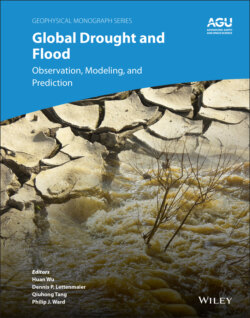Читать книгу Global Drought and Flood - Группа авторов - Страница 30
2.1. INTRODUCTION
ОглавлениеEvapotranspiration (ET) is the sum of water evaporated from Earth’s surface, from both land and ocean, and water transpired from vegetation. Thus, ET is commonly referred to as evaporation from the land surface, including soil surface evaporation, the evaporation of water intercepted by vegetation canopy, and the transpiration from vegetation stomata.
The latent heat needed for the evapotranspiration processes and transferred to the atmosphere is one of the most important components of the global or regional energy cycle. Partitioning of the available energy of a surface between latent heat (LE) and sensible heat fluxes can affect atmospheric motions and can influence local and regional weather via temperature and moisture advection and atmospheric motion. Evapotranspiration, or LE, is the largest energy source for the atmosphere and thus it is a critical factor for weather and climate formation (Rabin et al., 1990).
Evapotranspiration is a major component of the global water cycle. The hydrological budget of many land surfaces is the partitioning of precipitation between ET and runoff. The antecedent ET can largely determine the antecedent soil moisture condition, which in turn plays a significant role in the amount of runoff at the watershed scale (Loague & Freeze, 1985). Thus, many hydrological models for the monitoring or forecasting of streamflow require estimates of ET rates.
Both evaporation and transpiration require liquid water to be available for vaporization and the energy to be used to vaporize the water. The availability of the water and the energy varies significantly both spatially and temporally. Thus the spatial and temporal variations of ET could be tremendous. Lack or reduction of ET indicates low water availability or water deficit, i.e., drought. Therefore, observing ET is one approach to monitoring drought. For vegetated surfaces or crop fields, ET rates, especially transpiration rates, are closely related to the need of plants or crops to assimilate carbon for their maintenance and growth (Monteith, 1988). Thus, significant deviation from a potential or optimal ET rate indicates water stress for the plants or crops, i.e., agricultural drought. Monitoring agricultural droughts regionally or globally has significant economic and even political implications.
Local scale evapotranspiration is mostly observed using ground instruments, such as a lysimeter, the Bowen ratio, or eddy covariance tower. Regional and global scale evapotranspiration are estimated from modeling land surface or atmospheric water and energy budgets. Remote sensing approaches have been developed to retrieve regional or global scale evapotranspiration in recent decades (Courault et al., 2005; Kustas & Norman, 1996; Vinukollu et al., 2011). Because of the relatively low expense and continuous spatial coverage, satellite remote sensing of evapotranspiration has been applied to monitoring regional or global droughts in recent years. In this chapter, we give a historical sketch of the ET remote sensing studies and existing ET data products in the next section. Then in section 2.3 we describe how to use the Atmosphere–Land Exchange Inversion (ALEXI) model for operationally estimating ET and monitoring drought with observations in the Geostationary Operational Environmental Satellites’ (GOES) ET and Drought (GET‐D) product system of the National Oceanic and Atmospheric Administration’s (NOAA) National Environmental Satellite, Data, and Information Service (NESDIS). Section 4 presents an example of combining various satellite remote sensing data products, including ET, for monitoring drought. Finally section 5 discusses how satellite observations could provide operational global ET observations for climate studies and various societal applications.
